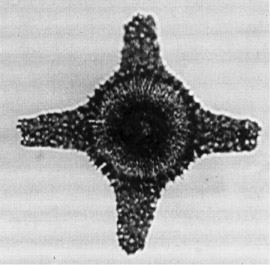 Lithocyclia
crux Moore
Lithocyclia
crux Moore Lithocyclia
crux Moore
Lithocyclia
crux MooreLithocyclia crux Moore, 1971, p.737. pl.6, fig.4
Phacoid cortical shell approximately two to three times as broad as medullary shell with subcircular to irregular pores. Cortical shell may be filled with spongy meshwork. Four arms, approximately perpendicular and in the same plane, are very irregularly pored to form spongy, subcylindrical columns. In rare specimens a spongy patagium is preserved. It connects the base of the arms and is formed parallel to the cortical shell. This species resembles Lithocyclia angustum (Riedel) in all respects except the number of arms (Moore, 1971).
Based on 30 specimens. Diameter of cortical shell 113-132 µm; of medullary shell (shadowy outline seen through cortical shell) 37-66 µm; Length of arms 75-168 µm; median breadth 22-47 µm (Moore, 1971).
Diameter of cortical shell 125-150 µm, width of arms medially 20-30 µm (Sanfilippo et al., 1985).
Four narrow spongy arms, approximately perpendicular to each other (Riedel and Sanfilippo, 1978a).
L. crux is distinguished from L. angusta by having four spongy arms rather than three, and from the L. aristotelis group by the arms being narrower (Sanfilippo et al., 1985).
This species varies in similar ways to L. angusta, but not to such a great extent. The meshwork of the cortical shell tends to be spongy in early specimens, and more regularly latticed in later ones. Arms vary in width, but have not been observed to be reduced to spines (Sanfilippo et al., 1985).
This species is found in practically all tropical localities of early Oligocene to early late Oligocene age - the exceptions being attributable to its sparseness. Its morphotypic first appearance lies within the Theocyrtis tuberosa Zone and its morphotypic last occurrence is approximately synchronous with the base of the Dorcadospyris ateuchus Zone.
This species developed from the L. aristotelis group, and it (or L. angusta) evolved into Didymocyrtis prismatica.
Additional illustrations can be found in Dinkelman, 1973, pl.5, fig.9; Johnson, 1974, pl.6, fig.5; Riedel and Sanfilippo, 1978a, pl.6, fig.7